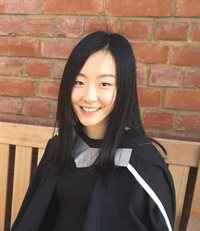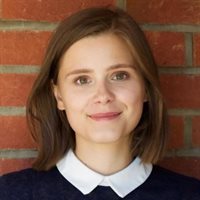Student research showcased at poster fair
The annual Faculty of Natural & Mathematical Sciences Poster Fair was held on 30 October 2018, with research presented by students from across the faculty. Four prizes were awarded this year for most impactful poster, scientific excellence, presentation quality and the interdisciplinary nature of research. The winners were Qi Hao, Janina Muench, Aran Sena and Emilie Steinmark.
 Qi Hao, Department of Informatics, won the prize for most impactful poster. Qi researches unsupervised relation discovery in documents, aiming to construct an unsupervised relation discovery model that is capable of discovering novel hidden patterns in text data using standard Natural Language Processing techniques (NLP), text mining techniques and machine learning.
Qi Hao, Department of Informatics, won the prize for most impactful poster. Qi researches unsupervised relation discovery in documents, aiming to construct an unsupervised relation discovery model that is capable of discovering novel hidden patterns in text data using standard Natural Language Processing techniques (NLP), text mining techniques and machine learning.
Her poster looked at an entity-based algorithm to extract multiple relationships from single sentences. Information extraction is the first step of her research.
Qi explained that she has chosen to work in this area as many fields have relied on text documents to process text data for the purpose of discovering novel cross-field patterns and relationships, yet this analysis is very labour-intensive as basic information has been manually extracted from text and annotated by hand.
Qi said: ‘I am truly honoured to win this prize. This is a great encouragement to my research. I want to thank my supervisors Dr Jeroen Keppens and Dr Odinaldo Rodrigues for their guidance and support. I will continue working on my PhD research to produce more impactful results.’
Qi will continue to work on relation discovery in documents by utilising the extracted information.
 Janina Muench, Department of Chemistry, won the prize for scientific excellence. Janina studies the quality control of a specific group of membrane proteins using a range of biophysical techniques including 19F (fluorine) NMR spectroscopy.
Janina Muench, Department of Chemistry, won the prize for scientific excellence. Janina studies the quality control of a specific group of membrane proteins using a range of biophysical techniques including 19F (fluorine) NMR spectroscopy.
Her poster described how she uses a biophysical approach to investigate a protein quality control mechanism that employs the co-chaperone SGTA. Janina hopes that by understanding more about the structure of this protein it will be possible to understand the mechanism by which cells sort ‘good’ from ‘bad’ proteins.
Janina explained she is inspired to work in this area because: ‘I am generally a very curious person who likes science and the logical approach it uses to discover new things. I think knowledge (of all sorts) and education are among the most important assets of any society and my intention is to increase knowledge by doing fundamental research (which is underlying many inventions/ applications).’
Janina will now try 2D fluorine NMR experiments in the hope to get even more structural information of the protein and its mode of interaction with substrates and will start to investigate the protein quality control pathway in vivo.
 Aran Sena, Department of Informatics, won the prize for presentation quality. Aran looks at machine learning methods that let robots learn to perform tasks with data collected from people. This research is being done to help develop new automation technologies for the horticulture industry.
Aran Sena, Department of Informatics, won the prize for presentation quality. Aran looks at machine learning methods that let robots learn to perform tasks with data collected from people. This research is being done to help develop new automation technologies for the horticulture industry.
His poster provided an overview of his research and a brief summary of his first experiment which was published earlier this year. The experiment investigated ways in improving the quality of the data provided by a person to a robot learning system - if the robot is learning from a person showing it what to do, it's performance will be strongly tied to how well the person shows it what to do.
Aran developed an interest in robotics during his undergraduate degree and followed it up with studying machine learning as part of his masters. Combining the two was a key part of his choice of PhD. Aran is currently involved in the GROWBOT research project which is sponsored by the Agriculture and Horticulture Development Board. He explained that a big motivation for the work he does has been meeting with farmers and others involved in the industry, and seeing how big a challenge securing labour can be for them, and the difficulties they've had in bringing automation into their processes for a variety of reasons.
Aran said: ‘It was great to meet researchers from the wider NMS group to see the variety of interesting research that is being done, and to share my work. It was a welcome surprise to win the prize for presentation quality! I've been doing a lot of public engagement work, and gave a few talks recently on my work to non-technical groups, which all seems to have helped improve my presentation skills.’
Aran is currently working on a journal article and hopes to carry out one last experiment before officially entering the write-up phase of his PhD.
 Emilie Steinmark, Department of Physics, won the prize for interdisciplinary nature of research. Emilie works in the area of experimental biophysics, specifically with a class of fluorescent molecules called molecular rotors that enables imaging of the viscosity inside cells.
Emilie Steinmark, Department of Physics, won the prize for interdisciplinary nature of research. Emilie works in the area of experimental biophysics, specifically with a class of fluorescent molecules called molecular rotors that enables imaging of the viscosity inside cells.
Her poster covered imaging viscosity inside mitochondria and in the mitochondrial membrane in order to find out how responsive those physical properties are to small changes in environment or physiology.
Emilie explained that she enjoys the interconnectedness of working in this area: ‘studying the physics of biology using chemistry reminds you that although discipline labels are sometimes useful, it’s impossible to pinpoint where one discipline stops and another starts. That means that all directions are open to you, it’s just a matter of perspective.’
Emilie said: ‘I’m really excited to win the prize, it’s always nice when other people, especially experts from different fields, see the value of one’s work.’
Emilie is working on the final chapter of her PhD: studying the effect of viscosity on diffusion-limited reactions in mitochondria and awaiting the publication of her paper.